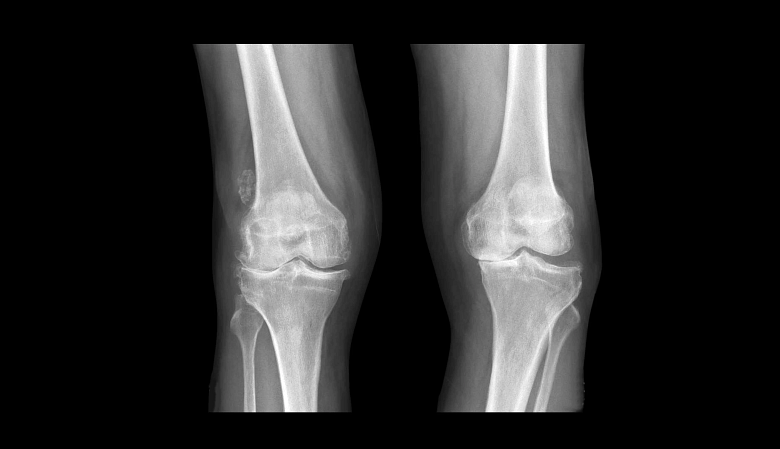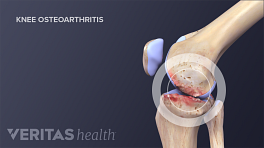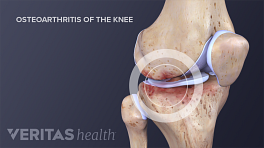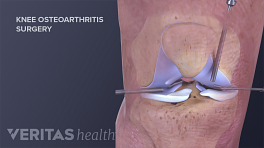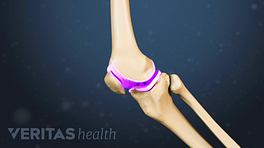In the future, doctors may be able to test blood or joint fluid for biomarkers that predict or identify the knee osteoarthritis. 1 Van Spil WE, Nair SC, Kinds MB, Emans PJ, Hilberdink WK, Welsing PM, Lafeber FP. Systemic biochemical markers of joint metabolism and inflammation in relation to radiographic parameters and pain of the knee: data from CHECK, a cohort of early-osteoarthritis subjects. Osteoarthritis Cartilage. 2015 Jan;23(1):48-56. doi: 10.1016/j.joca.2014.09.003. Epub 2014 Sep 6. PubMed PMID: 25205017. , 2 Kraus VB, Collins JE, Hargrove D, Losina E, Nevitt M, Katz JN, Wang SX, Sandell LJ, Hoffmann SC, Hunter DJ; OA Biomarkers Consortium. Predictive validity of biochemical biomarkers in knee osteoarthritis: data from the FNIH OA Biomarkers Consortium. Ann Rheum Dis. 2017 Jan;76(1):186-195. doi: 10.1136/annrheumdis-2016-209252. Epub 2016 Jun 13. PubMed PMID: 27296323; PubMed Central PMCID: PMC5851287. However, right now there is no standard lab test to verify the presence of knee osteoarthritis.
An x-ray showing a loss of space between the femur and tibia may indicate osteoarthritis.
In lieu of a single lab test, physicians commonly use five diagnostic tools to determine if a patient has knee osteoarthritis or another medical condition. These tools are described below.
In This Article:
- What Is Knee Osteoarthritis?
- Knee Osteoarthritis Symptoms
- Knee Osteoarthritis Causes
- Knee Osteoarthritis Diagnosis
- Knee Osteoarthritis Treatment
- Knee Osteoarthritis Video
Patient interview
A doctor will ask a patient about family history; when the knee pain began; whether other symptoms, such as stiffness, are present; what makes the pain better or worse; and how symptoms affect lifestyle. A patient’s reported symptoms are important for diagnosis and treatment.Physical exam
A doctor will physically examine the patient’s knee, noting any signs of swelling, pain points, stiffness and range of motion. The doctor may ask the patient to do certain physical tasks, such as squatting or walking across the room to observe the patient’s gait.See What Causes a Swollen Knee (Water on the Knee)?
X-rays
X-rays can show if there is a loss of joint space between the femur and tibia, indicating a loss of cartilage in the knee. An x-ray can also show bone spurs, a sign that the bones have tried to compensate for cartilage loss with extra bone growth.It is important to note that most individuals over age 50 will have signs of osteoarthritis in their knees that can be seen on an x-ray, but many will have no symptoms. In fact, some people may have x-rays that show significant signs of knee osteoarthritis and experience no pain, while others may have x-rays that show few signs of knee osteoarthritis and have significant pain.
X-rays are just one diagnostic tool and must be used in conjunction with the patient interview and physical exam.
MRI
Magnetic resonance imaging (MRI) provides a view of the soft tissue—cartilage, meniscus, ligaments, tendons and muscle—as well as bone. An MRI may be ordered if x-rays of the knee are inconclusive or if the doctor suspects symptoms are due to something other than osteoarthritis.An MRI is more time consuming than an x-ray, requiring the patient to remain perfectly still for about 30 minutes. It is also usually more expensive than an x-ray. An MRI is often not necessary.
Lab tests for other conditions
While there is no single lab test to diagnose knee osteoarthritis, a lab test can be used to rule out other problems, such as infection or gout, that also cause knee pain. Lab tests may require a blood draw or an aspiration the knee of joint (taking fluid from the joint).A doctor is trained to consider all the possible causes of the knee pain—ranging from a meniscal tear to rheumatoid arthritis—during the diagnostic process. He or she systematically eliminates possible causes until an accurate diagnosis can be made. Once the diagnosis is made, treatment can begin.
- 1 Van Spil WE, Nair SC, Kinds MB, Emans PJ, Hilberdink WK, Welsing PM, Lafeber FP. Systemic biochemical markers of joint metabolism and inflammation in relation to radiographic parameters and pain of the knee: data from CHECK, a cohort of early-osteoarthritis subjects. Osteoarthritis Cartilage. 2015 Jan;23(1):48-56. doi: 10.1016/j.joca.2014.09.003. Epub 2014 Sep 6. PubMed PMID: 25205017.
- 2 Kraus VB, Collins JE, Hargrove D, Losina E, Nevitt M, Katz JN, Wang SX, Sandell LJ, Hoffmann SC, Hunter DJ; OA Biomarkers Consortium. Predictive validity of biochemical biomarkers in knee osteoarthritis: data from the FNIH OA Biomarkers Consortium. Ann Rheum Dis. 2017 Jan;76(1):186-195. doi: 10.1136/annrheumdis-2016-209252. Epub 2016 Jun 13. PubMed PMID: 27296323; PubMed Central PMCID: PMC5851287.
